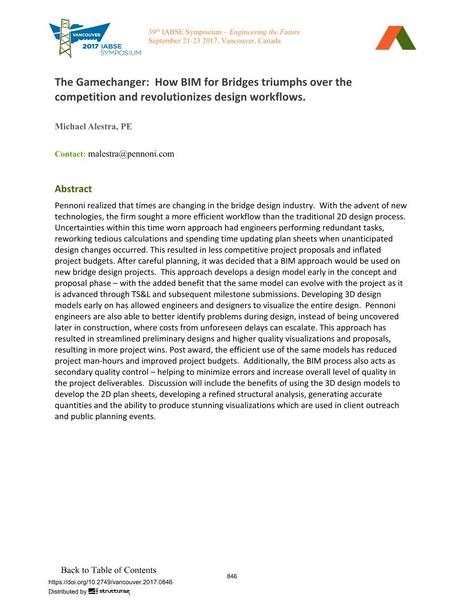The Gamechanger: How BIM for Bridges triumphs over the competition and revolutionizes design workflows.

| Autor(en): |
Michael Alestra
|
|---|---|
| Medium: | Tagungsbeitrag |
| Sprache(n): | Englisch |
| Tagung: | IABSE Symposium: Engineering the Future, Vancouver, Canada, 21-23 September 2017 |
| Veröffentlicht in: | IABSE Symposium Vancouver 2017 |
| Seite(n): | 846 |
| Jahr: | 2017 |
| DOI: | 10.2749/vancouver.2017.0846 |
| Abstrakt: |
Pennoni realized that times are changing in the bridge design industry. With the advent of new technologies, the firm sought a more efficient workflow than the traditional 2D design process. Uncertainties within this time worn approach had engineers performing redundant tasks, reworking tedious calculations and spending time updating plan sheets when unanticipated design changes occurred. This resulted in less competitive project proposals and inflated project budgets. After careful planning, it was decided that a BIM approach would be used on new bridge design projects. This approach develops a design model early in the concept and proposal phase – with the added benefit that the same model can evolve with the project as it is advanced through TS&L and subsequent milestone submissions. Developing 3D design models early on has allowed engineers and designers to visualize the entire design. Pennoni engineers are also able to better identify problems during design, instead of being uncovered later in construction, where costs from unforeseen delays can escalate. This approach has resulted in streamlined preliminary designs and higher quality visualizations and proposals, resulting in more project wins. Post award, the efficient use of the same models has reduced project man-hours and improved project budgets. Additionally, the BIM process also acts as secondary quality control – helping to minimize errors and increase overall level of quality in the project deliverables. Discussion will include the benefits of using the 3D design models to develop the 2D plan sheets, developing a refined structural analysis, generating accurate quantities and the ability to produce stunning visualizations which are used in client outreach and public planning events. |
0.14 MB
- Über diese
Datenseite - Reference-ID
10298712 - Veröffentlicht am:
02.02.2019 - Geändert am:
21.05.2021



